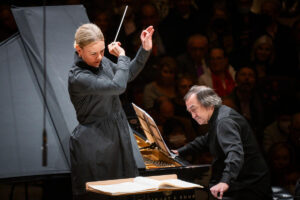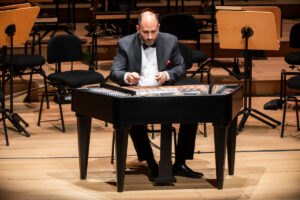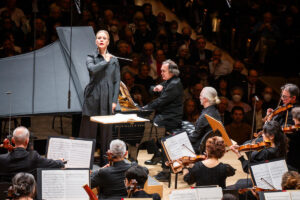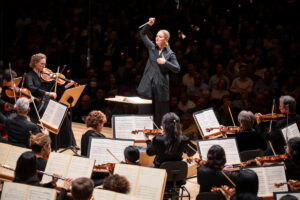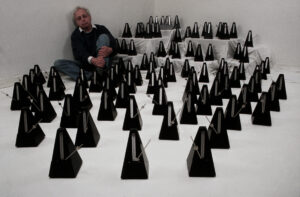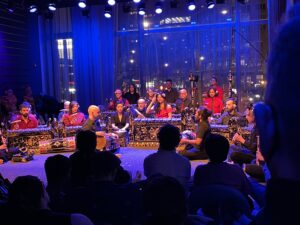A few months ago, I wrote an article that distilled the New York Philharmonic Fall 2023 season into enticing programs for contemporary music lovers.
“When you see New York Philharmonic’s glossy brochures and online ads, you might be hard pressed to spot the new music offerings that are in nearly every program. For instance, “Trifonov Plays Schumann” hides the fact that there is a work for strings by the Lithuanian composer Raminta Šerkšnytė, a composition which Gidon Kremer referred to as ‘the calling card of Baltic music.'”
Here is my annotation of Philharmonic concerts in Spring 2024 for the tiny niche of new music fans.
February 20, 2024 – Lunar New Year Hidden beneath Bruch and Saint-Saëns are two composers who are very much alive. The young Hong Kong-born composer Elliot Leung is making his mark in the Hollywood film scoring world, and the world premiere of his Lunar Overture leads the program. Grammy-nominated Chinese-American composer Zhou Tian is showcased with excerpts from Transcend, which was commissioned by over a dozen orchestras to commemorate the 150th Anniversary of the Transcontinental Railroad’s completion.
February 22-24 – Emanuel Ax, Hillborg, and Rachmaninoff This one’s right there in the tease: Hillborg. It would be natural to assume that Mr. Ax would be playing Rachmaninoff, and we’d get a five-minute piece by the Swedish composer Anders Hillborg. Nope. Hillborg wrote a 22 minute concerto: Piano Concerto No.2 – the MAX Concerto for Emanuel Ax, and we get to hear the New York premiere of the piece. San Francisco Chronicle’s Joshua Kosman said it was “vivacious, funny, heroic, eloquent, plain-spoken, thoughtful and wholly irresistible”. Now, don’t you want to go hear it?
February 29 – March 1 – Émigré The concert program title “Émigré” could mean just about anything. Here, it is the name of a “semi-staged musical drama” that weaves the true tale of German Jewish brothers who fled Nazi Germany and wound up in Shanghai. It was performed in Shangai in the fall, and the New York Philharmonic and conductor Long Yu give us the first American performances. Music by Aaron Zigman and lyrics by Mark Campbell.

March 7-9 – Sol Gabetta, Elim Chan, and Scheherazade Sure, cellist Sol Gabetta is great, and I’ll look forward to seeing the conductor Elim Chan who is making waves in Europe. The part of the program I am especially excited about is the world premiere by the Chickasaw composer Jerod Impichchaachaaha’ Tate. Pisachi, Tate’s tribute to Hopi and Pueblo Indian music, was commissioned by the New York Philharmonic. I’ve been a fan of Tate since a National Symphony premiere performance knocked my socks off 20 years ago.
March 21-24 – Mendelssohn, Tan Dun, and Joel Thompson A rare instance in which the new music is all in the program title. Joe Alessi plays the New York premiere of Tan Dun’s Trombone Concerto: Three Muses in Video Game. The thought of hearing it makes my heart go aflutter. Music by the Atlanta composer Joel Thompson seems to be everywhere lately, and the world premiere of To See the Sky (a NY Phil co-commission) is on this program.
April 4-6 – Alice Sara Ott Performs Ravel He’s dead, but you’d probably want to know that Anton Webern’s Six Pieces for Orchestra, Op. 6 is on this program. With any luck, the orchestra will play these shorties twice. Also dead: Scriabin. But as I recall, his Poem of Ecstasy is pretty trippy.
April 12-14 – Beatrice Rana Plays Rachmaninoff In addition to heavy hitters Rachmaninoff and Tchaikovsky, we get to hear the New York premiere of a new work by Katherine Balch, co-commissioned by the Philharmonic.

April 18-20 – Olga Neuwirth and Prokofiev’s Fifth Symphony Okay, Olga Neuwirth’s name is front and center. The US Premiere of Keyframes for a Hippogriff — Musical Calligrams is settings of texts by Ariosto, Emily Dickinson, Walt Whitman, Friedrich Nietzsche, graffiti artists, and Neuwirth. Brooklyn Youth Chorus sings. This is one of the NY Phil’s Project 19 commissions.
April 20 – Young People’s Concert: Composing Inclusion Yes, it’s a concert for kids, and the hall will be full of families. Show up to hear world premieres by Andrés Soto and Nicolás Lell Benavides, co-commissioned by the Philharmonic.
May 10 – Sound On This one is probably on your radar already. Another Project 19 commission, the world premiere of an as yet unnamed work by Mary Kouyoumdjian. Kwamé Ryan conducts.
May 23-28 – The Mozart Requiem and Sofia Gubaidulina’s Viola Concerto Finally. The title says it all.
